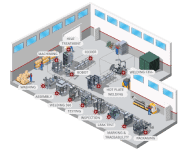Automated assembly lines use a variety of machines to control the processing and movement of materials. By fully automating an assembly line, manufacturers can produce a higher volume of products quicker with less human error, enhanced precision, and increased efficiency. Here, we’ll dive into the various components and benefits of a fully automated assembly line, as well as how it differs from semi-automated assembly lines.
Components of a Fully Automated Assembly Line
Fully automated assembly lines run with minimal human intervention, using automated feeding equipment and conveyor systems to feed or load parts into the machine. Once loaded, the part moves through various stations where different types of stations carry out the necessary manufacturing steps based on preprogrammed instructions. Common components of a fully automated assembly line include:
- Robotics. Robotics play a fundamental role in automated assembly lines. They can perform various types of repetitive manufacturing tasks, including painting, welding, assembly, and much more, with improved efficiency and reduced human error.
- Conveyor Systems. These systems are used to move products and materials between workstations.
- Automated Guided Vehicles (AGVs). These robots transport materials and products throughout a plant or warehouse environment, reducing the need for human workers to move heavy loads.
- Testing. Automated testing stations carry out the required tests to ensure a product meets predetermined criteria and adheres to the necessary standards.
- Marking and Traceability. These stations add crucial information, such as lot and batch numbers, to products to aid in traceability, quality assurance, and regulatory compliance.
- Packaging. Typically the final step in an assembly line, packaging robots can be programmed to pack individual products in various positions on trays, boxes, or pallets.
- Assembly. Robots are not always the ideal solution; non-robot assembly stations can perform assembly steps when convenient.
Benefits of a Fully Automated Assembly Line
Fully automated assembly lines offer the following benefits:
- Increased Productivity. Automation boosts productivity by increasing production speed, eliminating human error, and reducing manual labor.
- Consistency. Automation can carry out tasks with optimal consistency and accuracy, ensuring the same level of quality for each part.
- Cost-effectiveness. Automated machinery can perform repeated tasks 24/7 with fewer errors and little human intervention. This lowers labor costs as well as costs associated with wasted materials and reworking.
- Safety. Automation enhances safety by eliminating the need for human workers to perform repetitive or dangerous tasks.
- Improved Quality Control. Automated systems can include sensors and other inspection technologies to check for part defects and other errors. This results in less waste and improved product quality.
- Improved Use of Resources and Time. Automation allows human workers to focus on more complex tasks, enhancing overall production efficiency.
- Improved Customer Satisfaction. Because automated assembly lines offer higher speeds and enhanced precision, customers will receive products on time and with consistent quality.
Semi-Automatic Assembly Lines and How They Compare
While fully automated assembly lines use machines and robots to perform all manufacturing tasks, semi-automatic assembly lines combine machinery with human labor. This type of automation solution is well-suited for low-volume production lines that require a higher degree of flexibility and customization. Although semi-automated systems still incorporate various automated aspects, they require human intervention for loading/unloading materials, performing quality checks, and monitoring production processes.
Depending on your particular needs, semi-automated assembly lines may be a better solution, offering various benefits, such as:
- Increased flexibility
- Higher ROI
- Faster implementation times
- Lower capital costs
- Can solve bottleneck issues
Automate Your Assembly Line With Help From AMD
Whether you choose a fully-automated or semi-automated production line, automation can help to boost productivity, increase quality, and reduce human error. At AMD, we specialize in custom-built assembly line automation solutions. With expertise in manufacturing, engineering, and system integration, we can deliver quality automation solutions that meet your unique requirements.
The experts at AMD can visit your facility to help you determine which automation option is the best fit for your operation. Contact us or request a quote today to schedule a visit.

